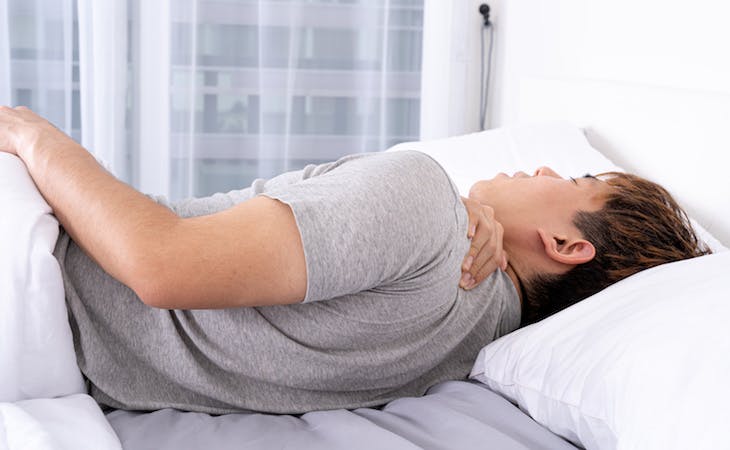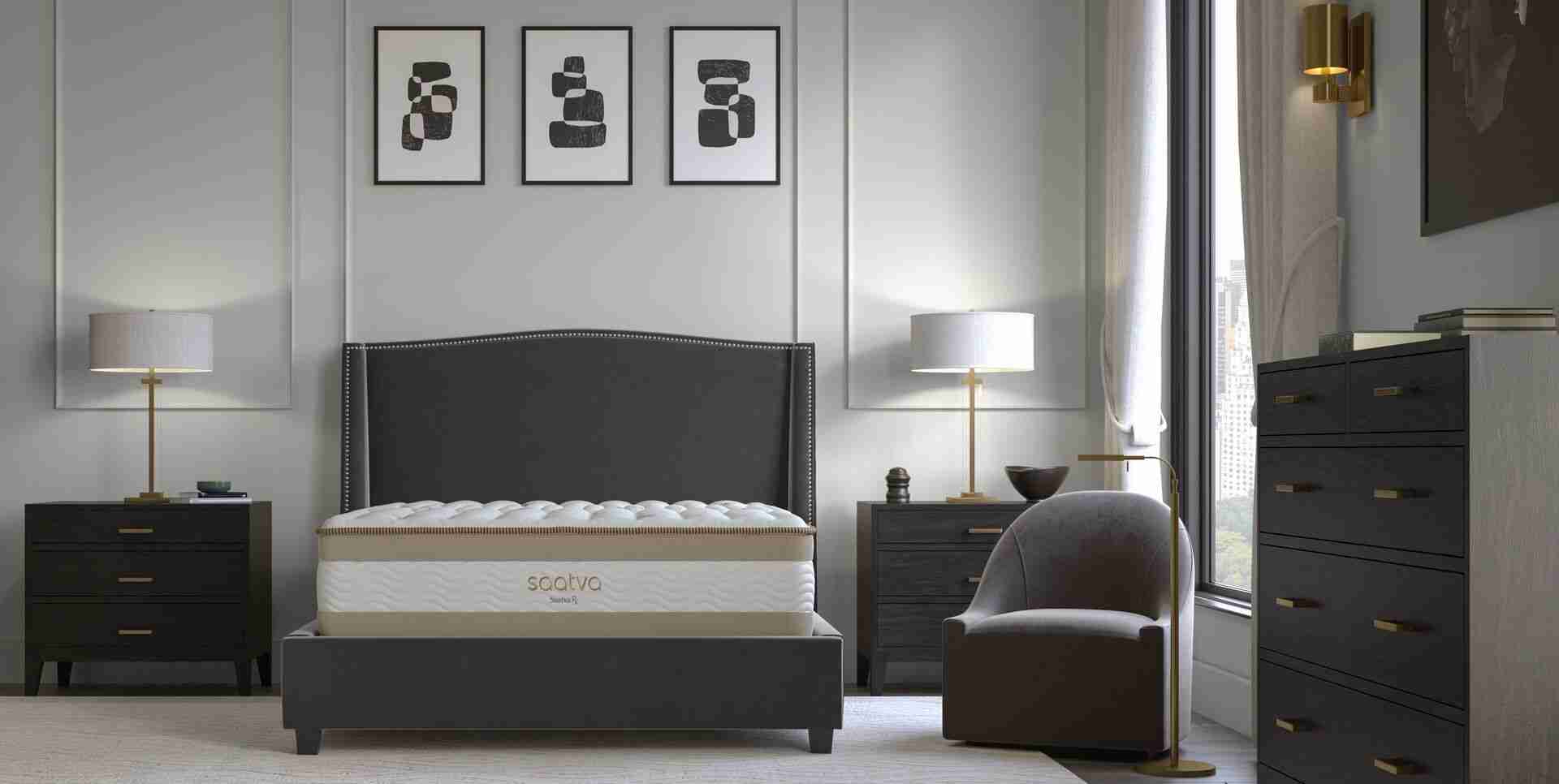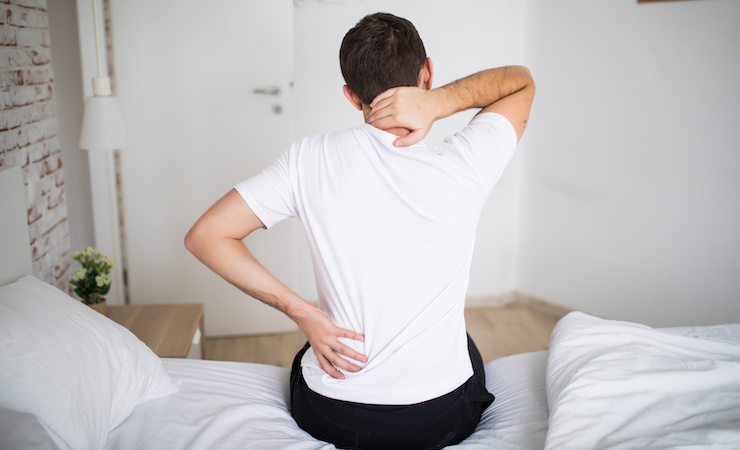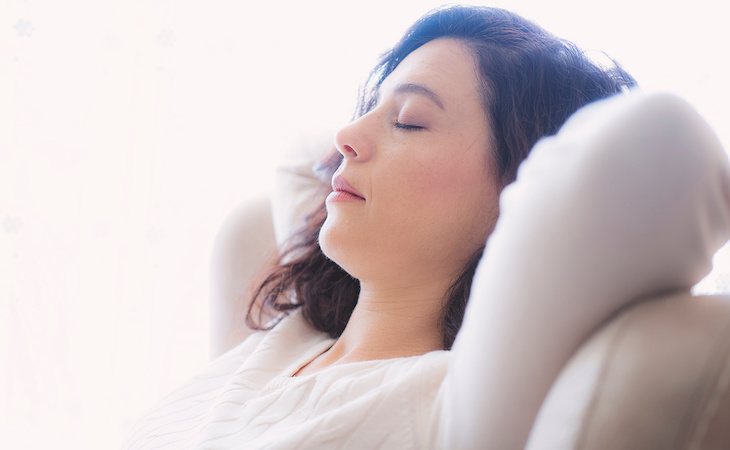There are a lot of things that can make it difficult to get a good night’s sleep. A barking dog. A ticking clock. A streetlamp shining into your window.
But those can all be considered minor annoyances compared to something that can really, truly disrupt sleep: a herniated disc.
We spoke with a top chiropractor for insight into what causes this particularly painful back condition, how to sleep better if you’re dealing with it, and how to find the best mattress for a herniated disc.
What is a herniated disc?
A herniated disc is an injury that can occur in any part of the spine.
Alex Tauberg, chiropractor and owner of Tauberg Chiropractic & Rehabilitation in Pittsburgh, explains the terminology and science behind a herniated disc: “The intervertebral disc is made up of two parts: an inner part of the nucleus pulposis and an outer part called the annulus fibrosis, which surrounds the nucleus,” he says. “One could think of this as being similar to a cream-filled donut.”
A herniated disc happens when the nucleus pushes through a crack in the annulus so that disc material is now outside the annulus. “The herniated material can either cause a localized inflammatory reaction which irritates the surrounding nerves, or it could directly impinge on those nerves,” says Tauberg.
Tauberg notes that a herniated disc doesn’t always result in pain. “Disc herniations are not uncommon for asymptomatic people,” he says, adding that one-third of people over 40 have a disc herniation without pain or dysfunction.
Prevention and sleep tips
While you can’t always prevent a herniated disc, there are some steps you can take to minimize your risk of developing one.
According to the Cleveland Clinic, some of the best ways to prevent a herniated disc include practicing good posture while sitting, standing, and sleeping, exercising regularly to keep leg, back, and stomach muscles strong, avoiding bending at the waist when lifting heavy objects, and maintaining a healthy diet.
Already have a herniated disc and wondering why it’s more uncomfortable at night? When you’re lying down, Tauberg explains, your spinal disc goes through a process called “imbibition.”
“Imbibition is when the spinal disc sucks up surrounding fluid,” he says. “In essence, this is the disc restoring hydration. When this happens, the disc becomes larger or possibly even swollen in nature. When someone has sciatica due to a herniation, this swelling can put more pressure on the nerve roots.”
As for how to get better rest with a herniated disc, it all comes down to your sleep position. Here’s how to improve your sleep, based on your preferred position:
Side sleeper
“Side posture is an acceptable sleeping position,” Tauberg says. “However, one should ensure they do not curl up when sleeping on their side. Curling up can cause the low back to enter a flexed state, which could be detrimental for a herniation.” Tauberg recommends placing a pillow in between your elbows and knees to allow your back muscles to be in a more neutral position.
Back sleeper
When it comes to sleep positions for a herniated disc, the back is the clear winner. “Ideally, it is best to sleep in a neutral position, such that the spine is neither hyperflexed nor hyperextended,” says Tauberg. “For most people, this means sleeping on their back.” Tauberg suggests placing a pillow under your knees, which can alleviate some of the tension “if one suffers from sciatica or similar radiculopathy [nerve root irritation].”
Stomach sleeper
If you only feel comfortable when you sleep on your stomach, you can sleep this way as long as you aren’t experiencing pain from your herniated disc. “That includes being able to be in the position without pain and being able to get up in the morning after sleeping in that position without pain,” Tauberg notes. If you do experience pain in this position, switch to sleeping on your side or back.
Mattress for herniated disc
When looking for the best mattress for a herniated disc, know that the right choice for you might not necessarily be the right choice for someone else.
“Picking a mattress is an individualized thing,” Tauberg says. “One should just ensure that they feel supported with whatever mattress they pick.”
To ensure your back is being protected in bed, look for a mattress with added lumbar support in the center third. You can find lumbar support in different forms, depending on the type of mattress you choose. Denser foams in the center third of the mattress or an area of reinforced springs are typical methods of lumbar zone enhancement.
Beyond lumbar support, there are a few other factors to consider that’ll help you determine which mattress is right for you if you have a herniated disc.
Mattress type
You have a lot of options when it comes to mattress types, but no one type is inherently better than another for a herniated disc. Here’s a breakdown of the most popular mattress types.
Innerspring
An innerspring mattress is the most traditional mattress type, best known for that classic springy feel. It takes its name from the metal support coils that form the core of the bed. That essential quality of “springiness” is the innerspring mattress’s defining characteristic.
Most innerspring mattresses today also contain layers made with other materials, such as memory foam and latex, for added comfort, performance, and durability. While innerspring mattresses are a perfectly fine choice if you have a herniated disc, you may want to check out other, more advanced, mattress types that have different attributes that may appeal to your sleep needs.
Memory Foam
A memory foam mattress is one made from viscoelastic foam, a type of high-density polyurethane foam. Memory foam’s distinguishing feature is that it softens in response to heat and pressure, giving it that body-hugging feel. Because memory foam conforms to your body, it helps relieve pressure points and keep your spine in neutral alignment.
If you like the feel of memory foam, make sure to choose one that’s firm enough to keep you comfortable. “When firm enough, foam seems to be great for helping the body relax,” says Tauberg. “When too soft, the sinking-in effect seems to negatively affect back pain sufferers.”
Latex
A true latex mattress is made of 100% natural latex derived from the milky sap of the rubber tree, Hevea brasiliensis. Most latex mattresses are not made from a single block of foam. Instead, they are formed from several layers of latex of varying thickness and density.
Latex conforms to your body like memory foam, but it’s responsive and bouncy like innerspring. It adjusts to your curves rather than just sinking beneath your weight like some memory foam mattresses tend to do, making it ideal for back pain.
Hybrid
A hybrid mattress is a cross between two mattress types—typically innerspring and some sort of foam—for a “best of both worlds” sleeping experience. Hybrid mattresses will have thicker upper layers of foam than a traditional innerspring for added pressure relief for your back.
Adjustable Air
While other types of mattresses have support cores consisting of foam or springs, adjustable air beds contain individual air chambers that can be inflated or deflated to achieve a precise level of comfort. Being able to adjust the firmness of your mattress can provide increased support to the lumbar spine and help to decrease back stiffness first thing in the morning.
Firmness
Tauberg prefers a firmer mattress above all others for a herniated disc—although, he says that at the end of the day, one’s firmness preference is a personal choice depending on your pain.
“In general, a firmer mattress seems to be a better fit for back pain sufferers, but this is not universally true,” he notes. “Some people feel as though they have more support with a softer mattress while others feel more supported with a firm mattress.” For example, side sleepers often report more comfortable sleep on a softer mattress.
Cooling features
You might be wondering if cooling features, like graphite, cooling gel, and organic cotton, may add to your herniated disc pain relief. Tauberg says sleeping cool may improve overall sleep, even though there’s no evidence staying cool at night will help with back pain.
“With that said, there is some evidence that people sleep better when cooler,” he says. “If a back-pain sufferer slept better because they felt cooler, they could possibly recover faster—but this would likely be due to the restorative effects of sleep more so than the actual temperature of the mattress.”
Using a mattress topper can help alleviate some of the pain associated with a herniated disc while you sleep. Here are the best mattress toppers for back pain.





